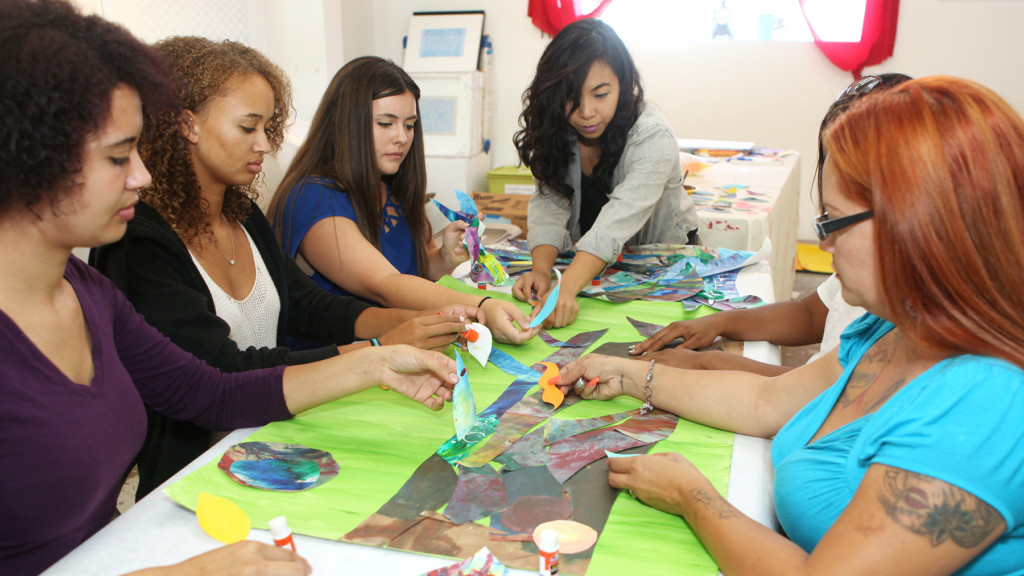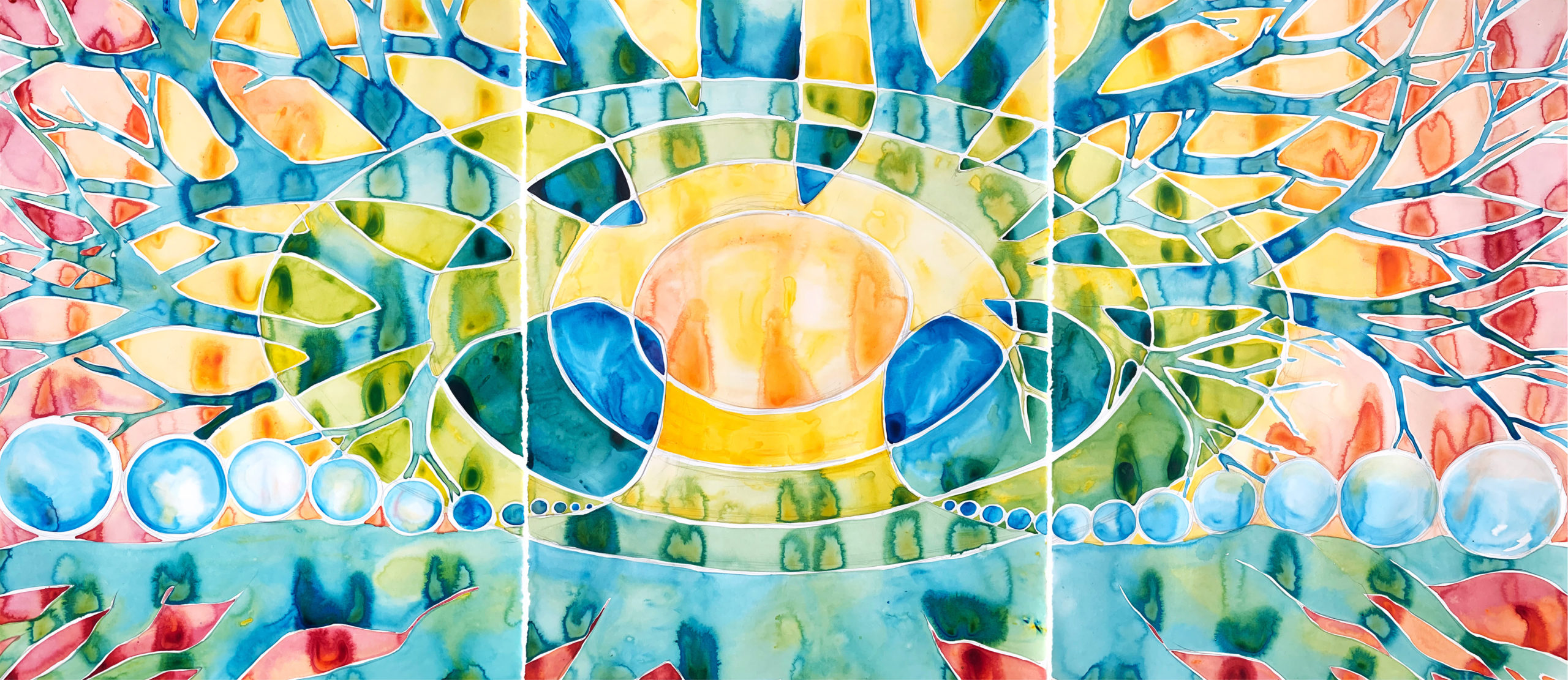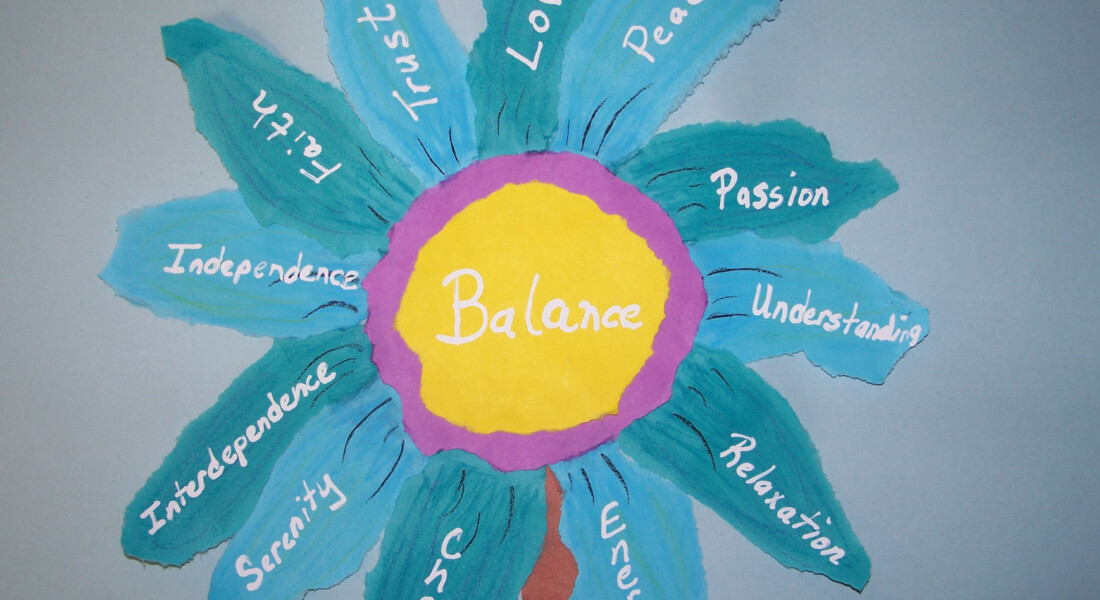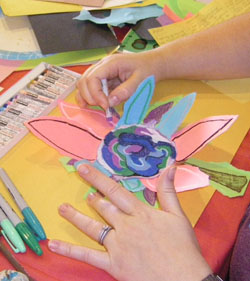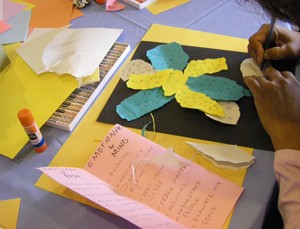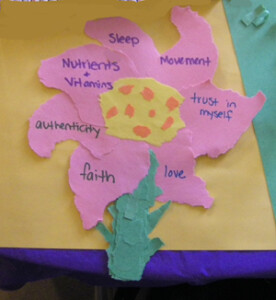It’s more important now than ever to take care of ourselves. What are some of your needs? Use this workshop to explore your needs, and your flower as a reminder to nurture them.
This is a sample of one of our 600+ workshops in the format it is presented to our trained facilitators. Though this version is written for creating with adults, all ages can benefit and are welcome to participate. Join us at a training to gain access to our entire library of workshops.
LEARN MORE ABOUT OUR TRAINING
DOWNLOAD PDF
Objective
This workshop aims to help participants focus on and honor their physical, emotional and spiritual needs, through the creation of a flower with each petal representing one of those needs.
Materials
• Colored journaling paper
• Pens
• Oil pastels (Cray-Pas preferred)
• Colored construction paper (or cardstock)
• Sharpies
• Glue sticks
Optional Materials
• Blank envelopes
• Timer
• Soft, relaxing music (to play in background during warm-up)
Timeframe
Introduction: 5 minutes
Demonstration: 10 minutes
Opening: 5 minutes
Warm Up: 20 minutes
Creation: 35 minutes
Closing : 10 minutes
Total: 1 hour, 25 minutes
Set-up
You can lay out all the supplies where they are easily accessible.
You may wish to prepare a sample in advance so that your demonstration can go quickly and leave plenty of time for creating. If you wish to do so, we suggest creating a simple sample so that participants aren’t overwhelmed by any “artistic” challenges.
As a facilitator, you have complete freedom to alter or adapt any portion or element of this workshop to cater to your specific group’s needs.
Introduction
“Many of us are willing to give ourselves to our families, our friends, our coworkers, etc. We’re often willing to sacrifice so much for others, that we forget to acknowledge and honor our own needs. Sometimes we don’t even take time to breathe. It can be such a blind spot for us and we are often not even aware of it.”
“This workshop is called Personal Needs Flower. Today, you will have an opportunity to take a window of time to notice and honor your physical, emotional, and spiritual needs; what you want more of in your life, or what might be out of balance and needs your attention. Tending to your needs is a vital part of self-care and one of the most important jobs you have. It is not only important, it is necessary for each of you to respect and honor your needs so you can recharge your batteries and be there in greater ways for yourself and others. You will then get a chance to create a flower, where each petal represents one of those needs.”
“Before we begin, I want you to know that this workshop is a window of time for you. This means that this can be a safe space to notice your thoughts, feelings, and needs. Since this space is your window of time, everything you say or do is voluntary. I’ll offer a suggested workshop idea, share about the materials we have available, and invite you to create, but there’s no right or wrong way to do this. It doesn’t matter what it looks like. What matters is taking this time to truly honor your thoughts and feelings, however they come out. If you can’t think of anything or draw a blank on what to create or write, feel free to just observe. However you choose to spend this time will be perfectly okay. This is your time. Please ask for what you need, and know that I’m here in support of you.”
Demonstration
If you’ve made a sample, you may wish to pass it around at this time.
“First, I’ll invite you to start with a journaling exercise to help you notice your needs. I’ll demonstrate the materials and creation process now, so that at the end of the journaling process, if you choose to, you can dive right into creating.”
“As I demonstrate the steps, remember that more than anything else, this is your special time to listen to and trust your own needs. There is no right or wrong to what you create. Just listen to the voice inside of you as you go. Whatever emerges in your creative process is fine. You are the expert of your own experience.”
“I am going to be demonstrating a flower, but your creation can be anything you like. It does not even have to look like a flower. For example, you could create a deck of cards, where each card represents a specific need.”
Step 1: Creating the Center
“The first step is creating the center of your flower.”
“With the colored paper, you can tear a circle as small or as large as you like. You can create this center to represent you. You might want to draw a face that represents the peaceful, nurturing, supportive part of yourself that is here to help you. Whatever you choose, is up to you. I’d like to encourage you to feel free to ‘tear’ the paper. This is an opportunity to let go and enjoy the freedom that tearing allows. Allowing ourselves to be curious and playful can help us discover needs we might not even be aware of.”
Step 2: Creating the Petals
“The next step is creating the petals, each one representing one of your needs.”
“To make each petal, you can choose any color paper and tear it into whatever shape or size you want. You may want to vary the size of the petals to illustrate the importance of each need. For example, one of your greatest needs might be ‘peace,’ so you can choose to tear a large piece to represent that, and a smaller need of yours might be ‘entertainment’ so you can use a smaller petal for that. These are only suggestions. You are free to design it however way it has meaning to you.”
“Then, if you like, you can draw symbols or use words to represent each need. Feel free to use your imagination to create colorful representations of all that you discover. You can place each petal, adding layer upon layer to the flower-like shape.
3. Completing your Flower
“The final step is deciding how you want to finish your flower. Using a glue stick you can attach your petals together or glue them onto a larger piece of construction paper or collect them into a pile that can travel with you. If you are going to keep your petals loose, you might want to decorate an envelope to keep them in.
“The final step is deciding how you want to finish your flower. Using a glue stick, you can attach your petals together or glue them onto a larger piece of construction paper, or collect them into a pile that can travel with you. If you are going to keep your petals loose, you might want to decorate an envelope to keep them in (if envelop is provided).”
“You can finish your flower whichever way will best support you in being reminded of the needs you noticed today, but also in the ongoing process of discovering more of your needs. You could even make some extra petals without anything on them yet so you can add more needs as you discover them.”
Opening
“If you feel comfortable doing so, I invite you to think about your wants and needs in order to feel safe, happy, and healthy. If any of you like, I’d like to encourage you to share one word about a need that is coming to mind. Is there some need that’s asking for attention right now? First thoughts are fine.”
You can thank and validate each participant for honoring their needs whether they chose to share or not.
Warm Up
“You are welcome to follow along with this warm-up exercise, or if you prefer, you can just observe. Observing is participating.”
“For those of you who wish to participate, first, I invite you to pick a color paper that speaks to you or makes you feel strong and hopeful.”
“If you choose to, you can journal about three different types of needs that we all have: the needs of our body, our mind, and our spirit. You can fold that paper into thirds lengthwise (show example; see images for reference). On the top of the first column, I invite you to write the word ‘Physical,’ on the second, ‘Emotional,’ and on the third, ‘Spiritual’.”
“I’m going to talk a little bit about each of these three needs then give you a few minutes (you can time this, if you like) after each one to reflect on, and write about this need for yourself. There is no right or wrong way to do this journaling exercise. You can write sentences, words, lists, draw symbols, shapes, or anything else you like. I’d like to encourage you to just allow your thoughts to flow onto your paper without judgment. This is your space and your time.”
“What you write does not have to make sense to anyone but you. It is also fine to just sit quietly and notice what comes up. Remember this is your window of time to connect with yourself and what’s meaningful for you.”
(You can play soft, background music if you choose to provide it at this time).
“Physical needs are what we usually think about first. What are your physical needs in order to feel safe, happy, and healthy?”
“For example, we need to be free from harm. We need shelter and a safe place to live. We need good nutrition: healthy food and clean water. We need exercise. Keeping our bodies healthy and strong. We need rest, giving us energy to do what we need to do, like succeeding at work or going to school.”
“In the first column, I invite you now to write words, sentences, symbols or shapes to represent your physical needs.”
(You can give participants are much time as you see fit to write; about 2-5 minutes usually suffices).
“Another need that may be a little harder to think about is our emotional needs. What are your emotional needs in order to feel safe, happy, and healthy?”
“For example, feeling understood, accepted, and heard. Knowing that we are loved and appreciated also gives us the feeling of having emotional support. Relaxation, fun, and friendship help us to find emotional balance. Having boundaries, realistic expectations, and a positive attitude are other ways of supporting our emotional health.”
“Now in the second column, I invite you to begin journaling about your emotional needs.”
(Pause to allow them to write).
“Finally, we will address our spiritual needs. What does your spirit need to give you peace?”
“For example, the ability to forgive, have patience or acceptance of others? Do you need quiet time to reflect, meditate, or pray? Do you need to do good deeds or help others feel uplifted? Do you need ‘me’ time to care for your soul?”
“In the third column, I invite you to journal about your spiritual needs.”
(Pause to allow them to write).
“Thank you for taking the time to reflect on and honor your own personal needs. Remember that you are worth it and representing your needs shows that they are, too.”
Creation
“Now I invite you to begin creating.”
As the participants create their flowers, you can remind them that there is no right or wrong way. The only important thing to keep noticing and honoring their own needs. You can encourage them to keep asking the question, “What are my needs?”
You can also encourage each participant to decide how they want to finish their flower. Do they want to glue it together? Do they want to create any extra petals to carry with them to add more needs as they are discovered? Or do they wish to keep the petals separate and keep them in an envelope (if provided).
Closing
For the closing, you can give participants who feel comfortable doing so an opportunity to share about their Personal Needs Flower, and any discoveries they made as they took time to notice their needs. Of course, this is optional, and if no one feels comfortable sharing, that’s perfectly okay.
You can remind participants: “This process does not end today. You can reflect back on it anytime, however it best serves you. Noticing what you need to feel safe, happy and healthy in your life is one of the most important jobs you will ever have, and one job that no one else can do for you.”
You can encourage participants to continue the journaling exercise at home and to keep identifying more of their physical, emotional and spiritual needs.
Notes
Note About Conflicting Needs:
Sometimes a person might notice that their different needs seem to be in conflict with each other. For example, the need to have more quiet alone time and the need to spend more playful, fun time with her children. This is okay.
The purpose of this workshop is to reveal the many needs that can be seen as part of our entire makeup. It is okay not to be problem-solving at this time, but rather supporting participants as they reveal and learn to accept themselves at this creative stage, seeing not only the needs that can be fulfilled, but also those that seem far from resolution.
By putting all the needs around a single circle, we allow our conscious mind to see how they all can coexist and intersect, and how we can begin to find safer and more creative ways to embrace and move through any conflicts.


